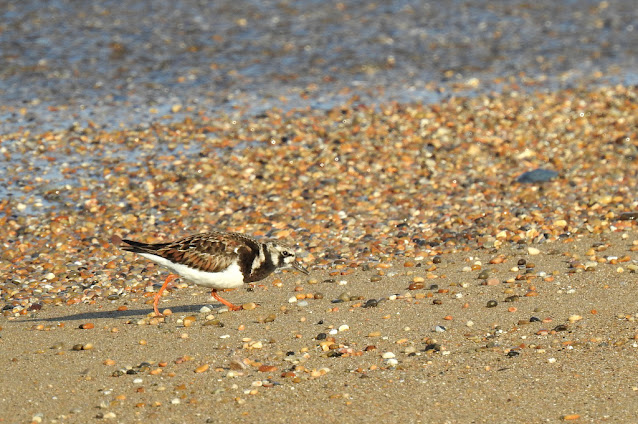Locally this spring I have used seawatching spots at West Bay, Burton
Bradstock and Cogden. Each has its pros and cons, but yesterday morning I chose
the West Bay shelter, and here's why...

|
When a Bridport birder is slobbing about indoors and procrastinating
about going seawatching, this is just the rocket he needs.
|
Steve made sure we all got the news, and I was out in a flash. To be honest I
thought the chances of a Long-tailed Skua rounding the Bill and heading
towards the coast were pretty slim, but if it did I wanted to give it the best
possible chance of coming within viewing range. West Bay is not only my
nearest spot, but also the furthest west of my options. Between 06:50 and
08:05 I was entertained by 2 Arctic Skuas, 14 Common Scoters, 5
Kittiwakes, a Great Northern Diver and a Sandwich Tern.
All very nice, but top spot went to a 2nd-summer
Yellow-legged Gull which was feeding offshore with
Herring Gulls, and surprisingly easy to identify in the excellent
light. Neither I nor anyone else who had been galvanised into action by the
Portland news had even a sniff of a Long-tailed Skua, but I doubt there
were any regrets about making the effort. I certainly had none.
By lunchtime the wind had escalated to something approaching gale force I
would say, and was accompanied by driving rain. I was confident that any
skuas would be sitting this out, so a mid-afternoon message that James
M was getting the odd Arctic Skua past Lyme Regis was a surprise. Out
again then...
The West Bay shelter was just about viable. If the wind had swung a little
further west of south I would have been getting very wet. As it was, the view
was pretty decent, though visibility limited by the soggy murk. There was
always something to look at, with a constant turnover of feeding gulls
providing at least a handful of birds at a time. The only gull of note was a
brief 1st-summer Med Gull, but thankfully there was also more
traditional seawatching fare, including 19 Manxies, a
Kittiwake and an Arctic Skua. But the principal players were
much smaller. At 16:22 the first of five Storm Petrels skittered
effortlessly past into the wind, close enough to follow it for a few seconds
in the hefty sea. The last - two together - went by at 17:20.
Stormies are always a treat, but especially good value in rough
weather. Watching them make light work of a gale is pretty awesome.
 |
West Bay yesterday afternoon. A ropey phone pic, but look at that sea!
|
This morning I was up at the crack, hoping that yesterday's weather had pushed
loads of seabirds into Lyme Bay and that they would all parade past me at
Cogden. I was encouraged by a Storm Petrel heading east quite close
in at 06:04, but apart from a single Great Northern Diver, in an hour a forty minutes there were only three other entries in my
notes, all flocks: 11 Common Scoter E, 12 Sanderling and 14
Dunlin W. It was achingly slow, and I had to sit out a lengthy downpour
beneath a brolly. By 07:30 I'd had enough.
I think that was the last hurrah, and my spring seawatching might now be over...
This evening I was at Cogden again, just for a walk on the beach. I honestly
thought there would be no birds worth mentioning, but a couple of
Swifts heading west were obviously migrants and, best of all, this...
 |
Gorgeous Wheatear in the evening sun. My first since May 15th!
|
 |
Look at the colour of this beaut! Definitely not one of ours, I suspect it still has a long journey ahead.
|
I thoroughly enjoyed my walk on the beach, and discovering that despite the appalling recent weather a passerine migrant had made the effort to cross the Channel was quite exciting. Last year, the next 16 days provided me with Golden Oriole, Blyth's Reed Warbler, 2 Rosy Starlings and a male Red-backed Shrike. While I'm not expecting lightning to strike twice, I'd like to think that this evening's Wheatear was a harbinger of something a little more exotic very soon...

















































